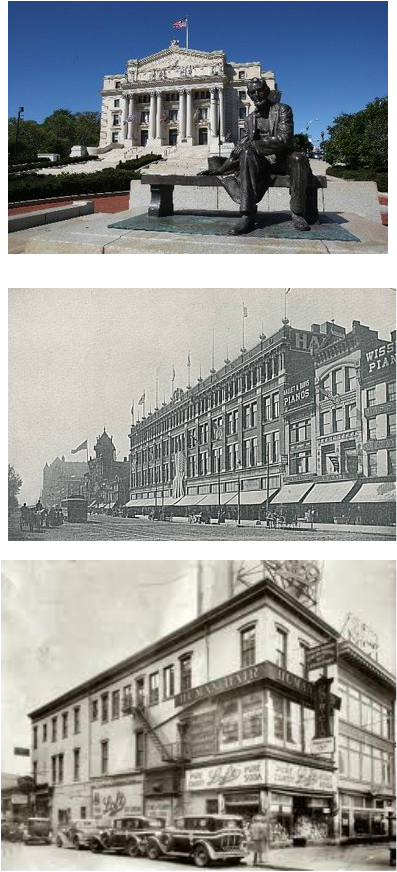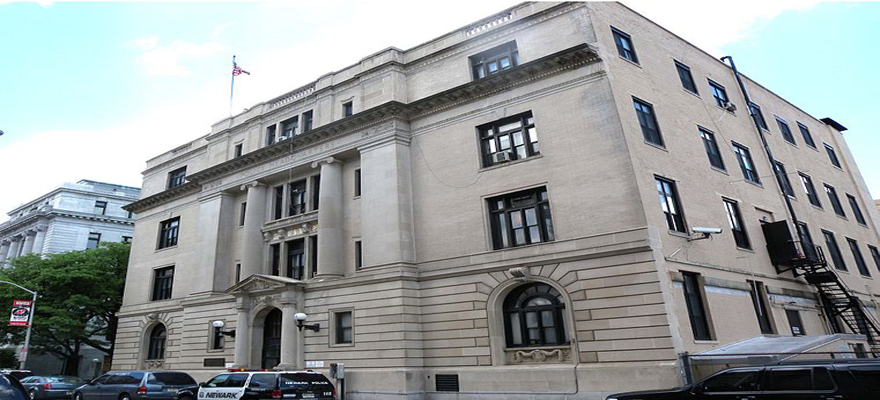NEWARK,NEW JERSEY
|
Located in ESSEX County, New Jersey
|

Newark,New Jersey Window Security Bars & Gates
Window Security Bars & Gates let you guard the things most precious to you. The truth is that burglars are often in and out of your home or business before anyone responds to an electronic alarm. With Window Security Bars & Gates preventing access, you don't have to worry.
When you live in the city, it's often necessary to Guard your windows & doors. Our custom sized Window Bars & Gates can be installed on the interior or exterior of the window, and can be painted an assortment of colors. We can fabricate custom sized Window Bars & Gates to fit any opening.
In New Jersey the law prohibits blocking any fire escape or bedroom window. We solve that problem with Fire Department Approved Gates that can be opened from inside without a key, giving you the protection you need without sacraficing safety. NJ Locksmith & Door Service Company also installs New Jersey approved Child Guards.
Window Security Bars & Gates let you guard the things most precious to you. The truth is that burglars are often in and out of your home or business before anyone responds to an electronic alarm. With Window Security Bars & Gates preventing access, you don't have to worry.
When you live in the city, it's often necessary to Guard your windows & doors. Our custom sized Window Bars & Gates can be installed on the interior or exterior of the window, and can be painted an assortment of colors. We can fabricate custom sized Window Bars & Gates to fit any opening.
In New Jersey the law prohibits blocking any fire escape or bedroom window. We solve that problem with Fire Department Approved Gates that can be opened from inside without a key, giving you the protection you need without sacraficing safety. NJ Locksmith & Door Service Company also installs New Jersey approved Child Guards.
NEWARK,NEW JERSEY
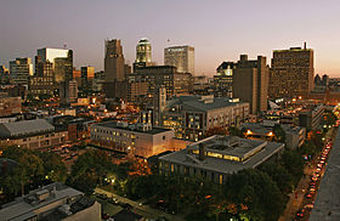
WB0206
Newark (pron.: /ˈnjuː.ərk/[14] or /ˈnjuːˌɑrk/[15]) is the largest city (by population) in the U.S. state of New Jersey, and the county seat of Essex County.[16][17] One of the nation's major air, shipping, and rail hubs, the city had a population of 277,140 in 2010, making it the nation's 67th most-populous municipality.
Located in the heart of New Jersey's Gateway Region, Newark is the second largest city in the New York metropolitan area, approximately 8 miles (13 km) west of Manhattan. Port Newark, the major container shipping terminal in the Port of New York and New Jersey, is the largest on the East Coast. Newark Liberty International Airport was the first municipal commercial airport in the United States and today one of its busiest.
Newark is headquarters to numerous corporations, such as Prudential Financial and PSEG. It is also home to several universities, including Rutgers–Newark, the New Jersey Institute of Technology, and Seton Hall University's Law School. Among others, its cultural and sports venues include: the New Jersey Performing Arts Center, the Prudential Center, and the Bears & Eagles Riverfront Baseball Stadium.
Newark is divided into five geographical wards, and contains neighborhoods ranging in character from bustling urban districts to quiet suburban enclaves. Newark's Branch Brook Park is the oldest county park in the United States and is home to the nation's largest collection of cherry blossom trees, which number about 4,300
Located in the heart of New Jersey's Gateway Region, Newark is the second largest city in the New York metropolitan area, approximately 8 miles (13 km) west of Manhattan. Port Newark, the major container shipping terminal in the Port of New York and New Jersey, is the largest on the East Coast. Newark Liberty International Airport was the first municipal commercial airport in the United States and today one of its busiest.
Newark is headquarters to numerous corporations, such as Prudential Financial and PSEG. It is also home to several universities, including Rutgers–Newark, the New Jersey Institute of Technology, and Seton Hall University's Law School. Among others, its cultural and sports venues include: the New Jersey Performing Arts Center, the Prudential Center, and the Bears & Eagles Riverfront Baseball Stadium.
Newark is divided into five geographical wards, and contains neighborhoods ranging in character from bustling urban districts to quiet suburban enclaves. Newark's Branch Brook Park is the oldest county park in the United States and is home to the nation's largest collection of cherry blossom trees, which number about 4,300
|
History Main article: History of Newark, New Jersey Newark was originally founded in 1666 by Connecticut Puritans led by Robert Treat from the New Haven Colony. The city saw tremendous industrial and population growth during the 19th century and early 20th century, and experienced racial tension and urban decline in the second half of the 20th century, culminated by the 1967 Newark riots. The city has experienced revitalization during the 1990s and early 21st century.[24] Newark was originally formed as a township on October 31, 1693, based on the Newark Tract, which was first purchased on July 11, 1667. Newark was granted a Royal charter on April 27, 1713, and was incorporated as one of New Jersey's initial 104 townships by an act of the New Jersey Legislature on February 21, 1798. During its time as a township, portions were taken to form Springfield Township (April 14, 1794), Caldwell Township (now known as Fairfield Township, February 16, 1798), Orange Township (November 27, 1806), Bloomfield Township (March 23, 1812) and Clinton Township (April 14, 1834, remainder reabsorbed by Newark on March 5, 1902). Newark was reincorporated as a city on April 11, 1836, replacing Newark Township, based on the results of a referendum passed on March 18, 1836. The previously independent Vailsburg borough was annexed by Newark on January 1, 1905. In 1926, South Orange Township, changed its name to Maplewood. As a result of this, a portion of Maplewood known as Ivy Hill was re-annexed to Newark's Vailsburg.[25] |
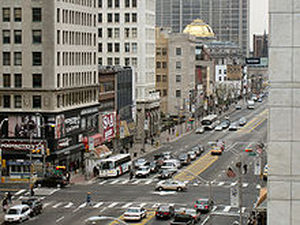
Neighborhoods
Main article: List of neighborhoods in Newark, New Jersey
Newark is New Jersey's largest and second-most racially diverse city (after neighboring Jersey City). It is divided into five political wards,[30] which are often used by residents to identify their place of habitation. In recent years, residents have begun to identify with specific neighborhood names instead of the larger ward appellations. Nevertheless, the wards remain relatively distinct. Industrial uses, coupled with the airport and seaport lands, are concentrated in the East and South Wards, while residential neighborhoods exist primarily in the North, Central, and West Wards.[31]
State law requires that wards be compact and contiguous and that the largest ward may not exceed the population of the smallest by more than 10% of the average ward size. Ward boundaries are redrawn, as needed, by a board of ward commissioners consisting of two Democrats and two Republicans appointed at the county level and the municipal clerk.[32] Redrawing of ward lines in previous decades have shifted traditional boundaries, so that downtown currently occupies portions of the East and Central Wards. The boundaries of the wards are altered for various political and demographic reasons and sometimes gerrymandered, especially the northeastern portion of the West Ward.[33][34][35]
Main article: List of neighborhoods in Newark, New Jersey
Newark is New Jersey's largest and second-most racially diverse city (after neighboring Jersey City). It is divided into five political wards,[30] which are often used by residents to identify their place of habitation. In recent years, residents have begun to identify with specific neighborhood names instead of the larger ward appellations. Nevertheless, the wards remain relatively distinct. Industrial uses, coupled with the airport and seaport lands, are concentrated in the East and South Wards, while residential neighborhoods exist primarily in the North, Central, and West Wards.[31]
State law requires that wards be compact and contiguous and that the largest ward may not exceed the population of the smallest by more than 10% of the average ward size. Ward boundaries are redrawn, as needed, by a board of ward commissioners consisting of two Democrats and two Republicans appointed at the county level and the municipal clerk.[32] Redrawing of ward lines in previous decades have shifted traditional boundaries, so that downtown currently occupies portions of the East and Central Wards. The boundaries of the wards are altered for various political and demographic reasons and sometimes gerrymandered, especially the northeastern portion of the West Ward.[33][34][35]
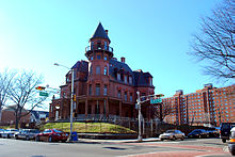
Newark's Central Ward, formerly known as the old Third Ward, contains much of the city's original history including the Lincoln Park, Military Park and the James Street Commons Historic Districts. The Ward contains the University Heights, The Coast/Lincoln Park, Government Center, Springfield/Belmont and Seventh Avenue Neighborhoods. Of these neighborhood designations only University Heights, a more recent designation for the area that was the subject of the 1968 novel Howard Street by Nathan Heard, is still in common usage. The Central Ward extends at one point as far north as 2nd Avenue. In the 19th century, the Central Ward was inhabited by Germans and other white Catholic and Christian groups. The German inhabitants were later replaced by Jews, who were then replaced by Blacks. The increased academic footprint in the University Heights neighborhood has produced gentrification, with landmark buildings undergoing renovation. Located in the Central Ward is the largest health sciences university in the nation, UMDNJ-New Jersey Medical School. It is also home to three other universities – New Jersey Institute of Technology (NJIT), Rutgers University - Newark, and Essex County College. The Central Ward forms the present-day heart of Newark, and includes 26 public schools, two police precincts, including headquarters, four firehouses, and one branch library.[36]

The North Ward is surrounded by Branch Brook Park. Its neighborhoods include Broadway, Mount Pleasant, Upper Roseville and the affluent Forest Hill section.[37] Forest Hill contains the Forest Hill Historic District, which is registered on state and national historic registers, and contains many older mansions and colonial homes. A row of residential towers with security guards and secure parking line Mt. Prospect Avenue in the Forest Hill neighborhood. The North Ward has lost geographic area in recent times; its southern boundary is now significantly further north than the traditional boundary near Interstate 280. The North Ward historically had a large Italian population; demographics have transitioned to Latino in recent decades, though the ward as a whole remains ethnically diverse.[37]
The West Ward comprises the neighborhoods of Vailsburg, Ivy Hill, West Side, Fairmount and Lower Roseville. It is home to the historic Fairmount Cemetery. The West Ward, once a predominately Irish-American, Polish, and Ukrainian neighborhood, is now home to neighborhoods composed primarily of Latinos, African Americans, Africans and Caribbean Americans.[38] The West Ward has struggled in recent years with elevated rates of crime, particularly violent crime.[39]
The South Ward comprises the Weequahic, Clinton Hill, Dayton, and South Broad Valley neighborhoods. The South Ward, once home to residents of predominately Jewish descent, now has ethnic neighborhoods made up primarily of African Americans and Latinos. The South Ward is represented by Council Member Ras Baraka. The city’s second-largest hospital, Newark Beth Israel Medical Center, can be found in the South Ward, as can 17 public schools, five daycare centers, three branch libraries, one police precinct, a mini precinct, and three fire houses.[40]
Finally, the East Ward consists of Newark's Downtown commercial district, as well as the Ironbound neighborhood, where much of Newark's industry was located in the 19th century. Today, due to the enterprise of its immigrant population, the Ironbound (also known as "Down Neck") is a destination for shopping, dining, and nightlife.[41] A historically immigrant-dominated section of the city, the Ironbound in recent decades has been termed "Little Portugal" due to its heavily Portuguese population. In addition, the East Ward has become home to Brazilians, Latin Americans, African Americans and commuters to Manhattan. Public education in the East Ward consists of East Side High School and six elementary schools. The ward is largely composed of densely packed housing, primarily large apartment buildings and rowhouses.
The West Ward comprises the neighborhoods of Vailsburg, Ivy Hill, West Side, Fairmount and Lower Roseville. It is home to the historic Fairmount Cemetery. The West Ward, once a predominately Irish-American, Polish, and Ukrainian neighborhood, is now home to neighborhoods composed primarily of Latinos, African Americans, Africans and Caribbean Americans.[38] The West Ward has struggled in recent years with elevated rates of crime, particularly violent crime.[39]
The South Ward comprises the Weequahic, Clinton Hill, Dayton, and South Broad Valley neighborhoods. The South Ward, once home to residents of predominately Jewish descent, now has ethnic neighborhoods made up primarily of African Americans and Latinos. The South Ward is represented by Council Member Ras Baraka. The city’s second-largest hospital, Newark Beth Israel Medical Center, can be found in the South Ward, as can 17 public schools, five daycare centers, three branch libraries, one police precinct, a mini precinct, and three fire houses.[40]
Finally, the East Ward consists of Newark's Downtown commercial district, as well as the Ironbound neighborhood, where much of Newark's industry was located in the 19th century. Today, due to the enterprise of its immigrant population, the Ironbound (also known as "Down Neck") is a destination for shopping, dining, and nightlife.[41] A historically immigrant-dominated section of the city, the Ironbound in recent decades has been termed "Little Portugal" due to its heavily Portuguese population. In addition, the East Ward has become home to Brazilians, Latin Americans, African Americans and commuters to Manhattan. Public education in the East Ward consists of East Side High School and six elementary schools. The ward is largely composed of densely packed housing, primarily large apartment buildings and rowhouses.
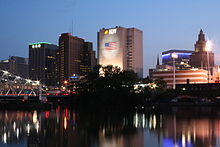
Economy
Newark is the third-largest insurance center in the United States, after New York City and Hartford.[115] The Prudential Financial and Mutual Benefit Life companies originated in the city. The former, one of the largest insurance companies in the world, is still headquartered in Newark. Many other companies are headquartered in the city, including IDT Corporation, New Jersey Transit, Public Service Enterprise Group (PSEG), Manischewitz, Horizon Blue Cross and Blue Shield of New Jersey.[116][117] and Audible.com.[118]
Though Newark is not the industrial colossus of the past, the city does have a considerable amount of industry. The southern portion of the Ironbound, also known as the Industrial Meadowlands, has seen many factories built since World War II, including a large Anheuser-Busch brewery. The service industry is also growing rapidly, replacing those in the manufacturing industry, which was once Newark's primary economy. In addition, transportation has become a large business in Newark, accounting for more than 17,000 jobs in 2011.[119]
The Consulate-General of Ecuador in New Jersey is located on the 4th Floor at 400 Market Street.[120] The Consulate-General of Portugal in Newark is located at the main floor of the Legal Center at One Riverfront Plaza.[121] The Vice Consulate of Italy is located in Suite 100 at 1 Gateway Center.Panasonic plans to leave its longtime North American headquarters in nearby Secaucus, New Jersey and move to a 250,000 square feet (23,000 m2) space in Newark in 2013, as part of a deal in which the company would receive over $100 million in tax incentives to add to the 800 employees it already has in New Jersey.[123]
Portions of Newark are part of an Urban Enterprise Zone. In addition to other benefits to encourage employment within the Zone, shoppers can take advantage of a reduced 3½% sales tax rate (versus the 7% rate charged statewide) at eligible merchants.
Newark is the third-largest insurance center in the United States, after New York City and Hartford.[115] The Prudential Financial and Mutual Benefit Life companies originated in the city. The former, one of the largest insurance companies in the world, is still headquartered in Newark. Many other companies are headquartered in the city, including IDT Corporation, New Jersey Transit, Public Service Enterprise Group (PSEG), Manischewitz, Horizon Blue Cross and Blue Shield of New Jersey.[116][117] and Audible.com.[118]
Though Newark is not the industrial colossus of the past, the city does have a considerable amount of industry. The southern portion of the Ironbound, also known as the Industrial Meadowlands, has seen many factories built since World War II, including a large Anheuser-Busch brewery. The service industry is also growing rapidly, replacing those in the manufacturing industry, which was once Newark's primary economy. In addition, transportation has become a large business in Newark, accounting for more than 17,000 jobs in 2011.[119]
The Consulate-General of Ecuador in New Jersey is located on the 4th Floor at 400 Market Street.[120] The Consulate-General of Portugal in Newark is located at the main floor of the Legal Center at One Riverfront Plaza.[121] The Vice Consulate of Italy is located in Suite 100 at 1 Gateway Center.Panasonic plans to leave its longtime North American headquarters in nearby Secaucus, New Jersey and move to a 250,000 square feet (23,000 m2) space in Newark in 2013, as part of a deal in which the company would receive over $100 million in tax incentives to add to the 800 employees it already has in New Jersey.[123]
Portions of Newark are part of an Urban Enterprise Zone. In addition to other benefits to encourage employment within the Zone, shoppers can take advantage of a reduced 3½% sales tax rate (versus the 7% rate charged statewide) at eligible merchants.

Panasonic plans to leave its longtime North American headquarters in nearby Secaucus, New Jersey and move to a 250,000 square feet (23,000 m2) space in Newark in 2013, as part of a deal in which the company would receive over $100 million in tax incentives to add to the 800 employees it already has in New Jersey.[123]
Portions of Newark are part of an Urban Enterprise Zone. In addition to other benefits to encourage employment within the Zone, shoppers can take advantage of a reduced 3½% sales tax rate (versus the 7% rate charged statewide) at eligible merchants.
Port Newark
Main article: Port Newark-Elizabeth Marine Terminal
Port Newark is the part of Port Newark-Elizabeth Marine Terminal and the largest cargo facility in the Port of New York and New Jersey. Located on Newark Bay, it is run by the Port Authority of New York and New Jersey and serves as the principal container ship facility for goods entering and leaving the New York metropolitan region and the northeastern quadrant of North America. The Port moved over $100 billion in goods in 2003, making it the 15th busiest in the world at the time, but was the number one container port as recently as 1985.[125] Plans are underway for billions of dollars of improvements - larger cranes, bigger railyard facilities, deeper channels, and expanded wharves.
Portions of Newark are part of an Urban Enterprise Zone. In addition to other benefits to encourage employment within the Zone, shoppers can take advantage of a reduced 3½% sales tax rate (versus the 7% rate charged statewide) at eligible merchants.
Port Newark
Main article: Port Newark-Elizabeth Marine Terminal
Port Newark is the part of Port Newark-Elizabeth Marine Terminal and the largest cargo facility in the Port of New York and New Jersey. Located on Newark Bay, it is run by the Port Authority of New York and New Jersey and serves as the principal container ship facility for goods entering and leaving the New York metropolitan region and the northeastern quadrant of North America. The Port moved over $100 billion in goods in 2003, making it the 15th busiest in the world at the time, but was the number one container port as recently as 1985.[125] Plans are underway for billions of dollars of improvements - larger cranes, bigger railyard facilities, deeper channels, and expanded wharves.
Crime
In 1996, Time magazine ranked Newark "The Most Dangerous City in the Nation."[107] By 2007, however, the city recorded a total of 99 homicides for the year, representing a significant drop from the record of 161 murders set in 1981.[108][109][110][111] The number of murders in 2008 dropped to 65, a decline of 30% from the previous year and the lowest in the city since 2002 when there were also 65 murders.[112]
In 2011, Newark recorded 90 homicides, after experiencing 86 homicides in 2010.[113] Overall, there was a 6% increase in crime numbers over the previous year, including a rise in carjackings for the third straight year.[114] Along with the increase in crime, the Newark Police Department increased its recovery of illegally owned guns in 2011 to 696, up from 278 in 2010.[113]
After being forced to lay off 162 officers due to economic reasons in 2010, the NPD was able to rehire eight of those officers in 2012, with plans for another 17 rehires later in the year.[113]
In 1996, Time magazine ranked Newark "The Most Dangerous City in the Nation."[107] By 2007, however, the city recorded a total of 99 homicides for the year, representing a significant drop from the record of 161 murders set in 1981.[108][109][110][111] The number of murders in 2008 dropped to 65, a decline of 30% from the previous year and the lowest in the city since 2002 when there were also 65 murders.[112]
In 2011, Newark recorded 90 homicides, after experiencing 86 homicides in 2010.[113] Overall, there was a 6% increase in crime numbers over the previous year, including a rise in carjackings for the third straight year.[114] Along with the increase in crime, the Newark Police Department increased its recovery of illegally owned guns in 2011 to 696, up from 278 in 2010.[113]
After being forced to lay off 162 officers due to economic reasons in 2010, the NPD was able to rehire eight of those officers in 2012, with plans for another 17 rehires later in the year.[113]
Newark Police Department (New Jersey)
The Newark Police Department is the primary law enforcement agency serving Newark, New Jersey.
The Newark Police Department is the largest municipal law enforcement agency in New Jersey. The department is headed by the police director Samuel DeMaio. The post of Chief of Police was abolished in 2008, when the job of Chief of Police was to handle day-to-day operations and the Director was to handle policy. However, the position of police chief was reinstated by the City Council in July 2011 and Sheilah Coley was appointed.[1]
2nd Precinct - North Ward
3rd Precinct - Ironbound District
4th Precinct - Central Ward
5th Precinct - South Ward
Special Operations Division
Administration Division
Newark Police Department
311 Washington St, Newark, NJ, United States
+1 973-733-6000 · newarkpd.org
The Newark Police Department is the primary law enforcement agency serving Newark, New Jersey.
The Newark Police Department is the largest municipal law enforcement agency in New Jersey. The department is headed by the police director Samuel DeMaio. The post of Chief of Police was abolished in 2008, when the job of Chief of Police was to handle day-to-day operations and the Director was to handle policy. However, the position of police chief was reinstated by the City Council in July 2011 and Sheilah Coley was appointed.[1]
2nd Precinct - North Ward
3rd Precinct - Ironbound District
4th Precinct - Central Ward
5th Precinct - South Ward
Special Operations Division
Administration Division
Newark Police Department
311 Washington St, Newark, NJ, United States
+1 973-733-6000 · newarkpd.org
Fire Department
MISSION AND PURPOSE
The Newark Fire Department is committed to reducing the loss of life and property of Newark citizens through recognized firefighting and emergency services.
The department is divided into the following divisions:
Administration, which provides financial and management support to all divisions in matters involving payroll, purchasing, budgeting, and general administration and provides strategic planning and information technology to all divisions.
Community Relations, which serves to strengthen the rapport between the Fire Department and the citizens of Newark by providing speakers to address civic organizations, schools, business groups, and others to inform them of fire prevention methods and safety practices in home, school, and business.
Construction and Maintenance, which maintains and repairs the department's fire alarm and telegraph system, which includes 800 private and public fire alarm boxes, signal consoles in fire stations and a 25-square mile area of overhead and underground cable.
Emergency Management, which assists the Fire Director; coordinates and delivers emergency disaster control services; and investigates emergencies involving hazardous material spills and other related matters in coordination with the Hazardous Materials Response Division.
Fire Prevention and Life Safety, which seeks to reduce the loss of life, property damage, and injuries from fire incidents through building inspections, code enforcement, construction plans review, fire safety education, and coordination with the Hazardous Materials Unit.
Fire Signal System Operation, which receives alarms, dispatches units, conducts all emergency radio communication, and controls the status and movements of all emergency units.
Firefighting, which responds to fire emergencies and other incidents to minimize life and property loss when fires or other emergencies occur.
Hazardous Materials Response, which enforces HAZ-MAT ordinances, inspects businesses and companies that use or store hazardous materials, and responds to hazardous material spills for mitigation of emergencies and dangers to the environment.
Investigations, which investigates suspicious fires and malicious acts and helps apprehend and prosecute perpetrators and conduct Internal Affairs investigations as necessary. Background investigations and residency checks for potential recruits are also performed under the internal affairs activity.
Operations, which receives alarms, dispatches units, conducts all emergency radio communications, controls the status and movement of all emergency units, records all alarm activity and radio traffic for future reference, regularly tests all alarm circuits, and coordinates special requests for emergency response from other agencies.
Photography and Media Liaison, which responds to and photographs various fire situations such as investigations, inspections, motor vehicle accidents involving Fire Department apparatus, and promotion and awards ceremonies; also contacts and releases detailed information to the news media.
Special Operations, which manages the increasingly diverse array of services offered by the fire department and is responsible for hazardous materials response; marine operations, including the fireboat and SCUBA Team; confined space, technical, and collapse rescue; large-scale foam operations; vehicle extrication, and any other operations outside the normal realm of firefighting.
Training, which conducts an ongoing training as mandated by state and federal law to provide the highest quality training and education for members of the Newark Fire Department, other city agencies, and the general public.
Follow the application instructions and mail the completed form to:
NJ CSC Fire Exam M9999M
P.O. Box 785
South Amboy, NJ 08879-0785
MISSION AND PURPOSE
The Newark Fire Department is committed to reducing the loss of life and property of Newark citizens through recognized firefighting and emergency services.
The department is divided into the following divisions:
Administration, which provides financial and management support to all divisions in matters involving payroll, purchasing, budgeting, and general administration and provides strategic planning and information technology to all divisions.
Community Relations, which serves to strengthen the rapport between the Fire Department and the citizens of Newark by providing speakers to address civic organizations, schools, business groups, and others to inform them of fire prevention methods and safety practices in home, school, and business.
Construction and Maintenance, which maintains and repairs the department's fire alarm and telegraph system, which includes 800 private and public fire alarm boxes, signal consoles in fire stations and a 25-square mile area of overhead and underground cable.
Emergency Management, which assists the Fire Director; coordinates and delivers emergency disaster control services; and investigates emergencies involving hazardous material spills and other related matters in coordination with the Hazardous Materials Response Division.
Fire Prevention and Life Safety, which seeks to reduce the loss of life, property damage, and injuries from fire incidents through building inspections, code enforcement, construction plans review, fire safety education, and coordination with the Hazardous Materials Unit.
Fire Signal System Operation, which receives alarms, dispatches units, conducts all emergency radio communication, and controls the status and movements of all emergency units.
Firefighting, which responds to fire emergencies and other incidents to minimize life and property loss when fires or other emergencies occur.
Hazardous Materials Response, which enforces HAZ-MAT ordinances, inspects businesses and companies that use or store hazardous materials, and responds to hazardous material spills for mitigation of emergencies and dangers to the environment.
Investigations, which investigates suspicious fires and malicious acts and helps apprehend and prosecute perpetrators and conduct Internal Affairs investigations as necessary. Background investigations and residency checks for potential recruits are also performed under the internal affairs activity.
Operations, which receives alarms, dispatches units, conducts all emergency radio communications, controls the status and movement of all emergency units, records all alarm activity and radio traffic for future reference, regularly tests all alarm circuits, and coordinates special requests for emergency response from other agencies.
Photography and Media Liaison, which responds to and photographs various fire situations such as investigations, inspections, motor vehicle accidents involving Fire Department apparatus, and promotion and awards ceremonies; also contacts and releases detailed information to the news media.
Special Operations, which manages the increasingly diverse array of services offered by the fire department and is responsible for hazardous materials response; marine operations, including the fireboat and SCUBA Team; confined space, technical, and collapse rescue; large-scale foam operations; vehicle extrication, and any other operations outside the normal realm of firefighting.
Training, which conducts an ongoing training as mandated by state and federal law to provide the highest quality training and education for members of the Newark Fire Department, other city agencies, and the general public.
Follow the application instructions and mail the completed form to:
NJ CSC Fire Exam M9999M
P.O. Box 785
South Amboy, NJ 08879-0785
